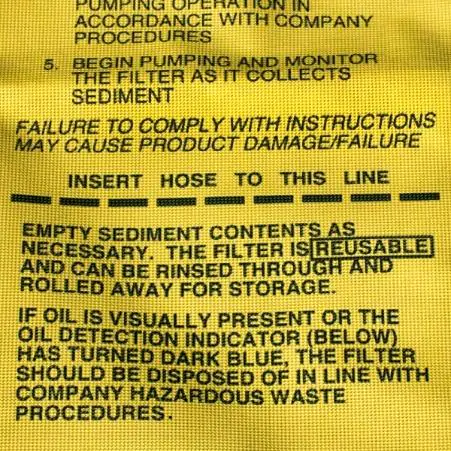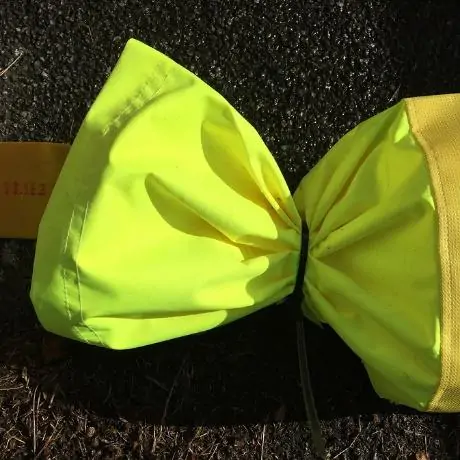How to Use Green Rhino Sediment Filters
Which filter are you using:
- Sediment or XL Sediment or Oil & Sediment
- Ultra-fine Sediment Filter
- Economy Sediment Filter
- Oil & Sediment Filter
Follow these instructions and you will find our sediment filters easy to use and long lasting. If you are unsure of the environmental regulations around discharging silt-laden water into the environment, read our Best Practice Guide to Dewatering Excavations.
Sediment / XL Sediment / Oil & Sediment
- These filters are designed to be used with a 2” pump.
- Each filter has instructions printed on the outside. Notice the dashed line with the instruction ‘Insert hose to this line’. Push the discharge hose inside the filter as far as this line.

- Using the reusable cable ties provided, secure the collar of the filter around the discharge hose. Tighten to 2/3rd the width of the hose. Do not use rope, chains or any other method that has no give.

- Position the filter near a suitable drainage point e.g. a drain or ditch.
- Once you start pumping, check that the cable ties are doing their job. Loosen/tighten as required.
- As the filter fills with sediment, pressure will increase and flow will decrease. The filter will need emptying to relieve the pressure. Finer silts may clog the filter before capacity is reached (you may need the Ultra-fine Sediment Filter). If pressure is allowed to build too high, the cable ties are designed to break before the bag splits.
- Tell-tale signs that a filter needs emptying are: reduced flow, filter bag looks packed and/or water is coming out through the collar.
- Filters can be emptied and reused until flow rate is too slow to be practical. We recommend that you flush them out with a hose in between uses to reduce clogging of the filtration media. This will extend the life of the filter.
- Each filter includes a hydrocarbon detection strip on the outer cover. If this strips turns dark blue then the discharge water is contaminated. Stop pumping immediately and clean the water at source. Use Green Rhino Oil Retention Pillows to soak up oil sheen. Note that the level of contamination will determine the colour change on the detection strip – from a light speckling to a solid colour change. If using an Oil & Sediment Filter, this indicates that the filter has reached hydrocarbon capacity and must be changed. Dispose of the filter as hazardous waste.

Ultra-fine Sediment Filter
- This filter has a female Camlock fitting to cope with higher pressure flow. It is designed to be used with a 2” pump. You will need a discharge hose with a male Camlock fitting.
- Position the filter near a suitable drainage point e.g. a drain or ditch.
- Monitor the filter during dewatering. As it fills with sediment, flow rate will reduce increasing the pressure inside the filter. If the filter bag looks full, flow rate has reduced significantly, or the pump is straining, pause pumping activities and empty the filter.
- Filters can be emptied and reused until flow rate is too slow to be practical. We recommend that you flush them out with a hose in between uses to reduce clogging of the filtration media. This will extend the life of the filter.
- Each filter includes a hydrocarbon detection strip on the outer cover. If this strips turns dark blue then the discharge water is contaminated. This indicates that the Oil Retention Pillow inside the Ultra-fine filter has reached capacity. Stop pumping immediately and replace the filter. Note that the level of contamination will determine the colour change on the detection strip – from a light speckling to a solid colour change. Dispose of the filter as hazardous waste. Use Green Rhino Oil Retention Pillows to soak up the contamination in the source water.

Economy Sediment Filter
- Economy Sediment Filters are for low volume and/or occasional work. They are designed to be used with a 2” pump.
- Push the discharge hose deep inside the filter. Using the reusable cable ties provided, secure the collar of the filter around the discharge hose. Tighten to 2/3rd the width of the hose. Do not use rope, chains or any other method that has no give.

- Position the filter near a suitable drainage point e.g. a drain or ditch.
- Once you start pumping, check that the cable ties are doing their job. Loosen/tighten as required.
- As the filter fills with sediment, pressure will increase and flow will decrease. The filter will need emptying to relieve the pressure. If pressure is allowed to build too high, the cable ties are designed to break before the bag splits.
- Tell-tale signs that a filter needs emptying are: reduced flow, filter bag looks packed and/or water is coming out through the collar.
- Filters can be emptied and reused until flow rate is too slow to be practical. We recommend that you flush them out with a hose in between uses to reduce clogging of the filtration media. This will extend the life of the filter.
